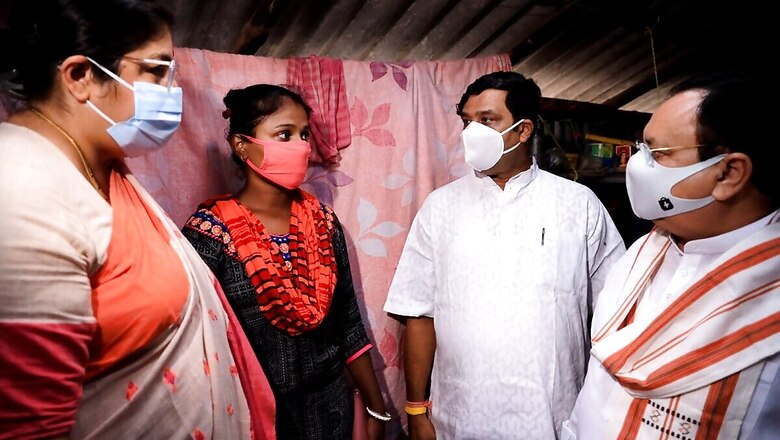
views
The first wave of COVID-19 pandemic swept away several lives and livelihoods in 2020. The year 2021 has turned out to be crueller, testing human resilience. Amid all this, there are always some anti-social elements that aim to shatter peace, target communities and unleash violence. In the aftermath of West Bengal Assembly election results, the Trinamool Congress can be accused of indulging in these activities.
Calcutta was the capital of India till 1912 and Bengal was the first to flourish in terms of industrial and business opportunities. Even after the capital was shifted to Delhi, Bengal remained the industrial powerhouse of India during Independence. However, by 1968, it had slipped below seaports like Bombay, Visakhapatnam and Mormugao. In 1959, West Bengal’s share in India’s total industrial output (in terms of ex-factory value) was 22.2 per cent while in 1975, it saw a sharp decline and fell to 10.9 per cent (as per data collected by India Today). Gross State Domestic Product or GSDP of Bengal between 2012-13 and 2017-18 was 5.5 per cent while the national average GSDP was 7.1 per cent (as per data collected by Hindustan Times). Almost all industrialists, who witnessed the social and political upheaval in Bengal, thought it fit to move their business out Bengal and take it to western states like Maharashtra and Gujarat. Most companies have their major offices and factories in all big cities, except in Kolkata, Bengal. And, this is a direct result of the political and social instability in the state.
Though West Bengal in recent times has seen state-sponsored violence—during the anti-CAA protests, protesters were seen attacking and damaging central government properties like railways, national highways—it is rare in a mob attack to identify the properties and then vandalise them. The post-election violence saw mobs allegedly attacking opposition party workers. The TMC’s frustration of losing Nandigram to BJP’s Suvendu Adhikari and the latter emerging as the principal opposition in Bengal (winning 77 of the 292 seats) was evident.
The first victim of the post-poll violence was Abhijit Sarkar, a BJP worker and an idol maker in Kolkata. As per the statements given by his brother Biswajit Sarkar, a rope was tied around Abhijit’s neck and he was dragged by a group of around 30 people and killed. Another victim, Haran Adhikari, also a BJP worker, was murdered in front of this family. Reports from Kolkata alleged that whosoever chanted Jai Shri Ram was beaten or hacked to death. According to BJP National President J.P. Nadda, 14 BJP workers have been killed within three days of election results in Bengal. Vandalization of homes of people connected or related to the BJP forced several thousands to flee.
Although the Ministry of Home Affairs sought a report from the Bengal government on the post-poll violence, the latter has evaded it. Not just the BJP, the CPM too alleged violence against them by the TMC workers right after the elections results were declared.
A century of communal and political violence have already changed the colour of the Bengali soil. The violence in Bengal did not start when the TMC rode to power in 2011 but much before Independence. The Noakhali riots in the Chittagong Division of Bengal laid the foundation stone of communal violence wherein Hindus were killed in large numbers.
After Independence, the Congress came to power and the degradation of West Bengal started, turning the state into a labour hub while damaging its reputation as an industrial zone. However, under the absolute reign of Jawaharlal Nehru, even Bengal’s then chief minister Bidhan Chandra Roy had no say in the changing of economic policies of Bengal. But everything changed when Marxists came to power in 1977 in Bengal. In fact, all of 1970s was marked by incidents of political violence. In 1971, All India Forward Bloc national secretary Hemanta Basu was murdered in Kolkata.
Severe clashes between the CPM and the TMC led to the downfall of the Left Front in 2011 and since then, the TMC has won three consecutive victories in Bengal. The TMC’s years in power too have faced similar allegations of political violence. In February 2012, CPM MLA Pradip Tah and Burdwan district leader Kamal Gayen were murdered, allegedly by TMC workers. The ‘Reign of Terror’ didn’t stop with the CPM leaders. Shockingly, as a result of violence unleashed by the TMC in Bengal, the party won 34 per cent panchayat seats uncontested in 2018. However, these panchayat polls led to the emergence of a new power in the state–the BJP. Although the BJP was never considered a challenger to the TMC in Bengal, the party won 18 of the 42 Lok Sabha seats in 2019. Soon, clashes erupted and 11 people were killed.
Just a cursory look at these facts shows that whenever the TMC is threatened by the rise of true democracy, the state gets engulfed by violence. Though BJP barely had any presence during the 2016 Bengal Assembly elections, this time, the party by winning 77 seats has directly threatened the TMC’s reign.
Amidst all the chaos in Bengal, the so-called secular brigade of this country has stayed silent over the violence committed by the TMC against the BJP cadre and against those who voted for the BJP. The Ministry of Home Affairs has formed a four-member team to investigate the post-poll violence in Bengal, which will submit its report soon. Violence in West Bengal has time and again hindered the state’s progress and economic growth.
Read all the Latest News, Breaking News and Coronavirus News here. Follow us on Facebook, Twitter and Telegram.














Comments
0 comment